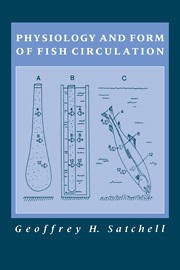Book contents
- Frontmatter
- Contents
- Preface
- 1 Introduction
- 2 The Heart
- 3 The peripheral circulation
- 4 The blood
- 5 Haemopoiesis and phagocytosis - the mononuclear phagocytic system
- 6 Circulation through special regions
- 7 Retial counter-current systems: flow–diffusion–concentration
- 8 Venous return and venous pumps
- 9 The autonomic nervous system
- 10 The response to exercise
- 11 The response to hypoxia
- 12 Myxine, a speculative conclusion
- References
- Appendix of popular and scientific names
- Index
3 - The peripheral circulation
Published online by Cambridge University Press: 05 February 2012
- Frontmatter
- Contents
- Preface
- 1 Introduction
- 2 The Heart
- 3 The peripheral circulation
- 4 The blood
- 5 Haemopoiesis and phagocytosis - the mononuclear phagocytic system
- 6 Circulation through special regions
- 7 Retial counter-current systems: flow–diffusion–concentration
- 8 Venous return and venous pumps
- 9 The autonomic nervous system
- 10 The response to exercise
- 11 The response to hypoxia
- 12 Myxine, a speculative conclusion
- References
- Appendix of popular and scientific names
- Index
Summary
Introduction
Simple dissection shows us that the circulatory system of a fish does not consist of a branching array of similar tubes, for four distinct types of vessel can be recognized: arteries, arterioles, capillaries and veins. Each performs a specific function and has a structure appropriate to this. Arteries provide for the distribution of blood to all parts of the body, with a minimum loss of pressure. Arterioles are short, narrow, muscular vessels which lower the pressure to a level at which it will not damage the delicate capillaries that lie ahead. The capillaries provide an extensive system where diffusion and exchange of nutrients and the respiratory gases can occur. The veins enable the blood to be returned to the heart and also provide a reservoir in which extra blood can be stored until needed.
Four tissue elements may be found in these vessels. All vessels are lined with a layer of thin flat endothelial cells, outside which three sorts of fibrous tissue elements may be present, each characterized by a particular protein. Elastic fibres consist of the protein elastin; when such fibres are stretched and released they tend to relax back to their original length. Collagen fibres consist of the protein, collagen; they have great tensile strength and tend to stretch very much less than elastic fibres. Smooth muscle fibres contain the proteins myosin and actin and can contract. They may be innervated so that contraction is under the control of the autonomic nervous system.
- Type
- Chapter
- Information
- Physiology and Form of Fish Circulation , pp. 41 - 57Publisher: Cambridge University PressPrint publication year: 1991



